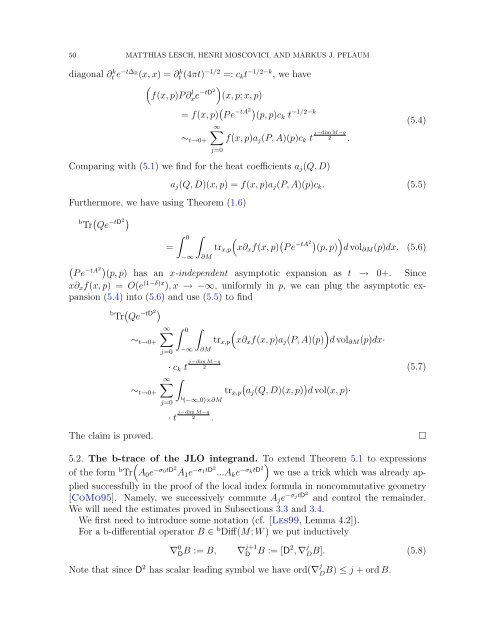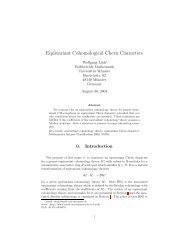Connes-Chern Character for Manifolds with Boundary and ETA ...
Connes-Chern Character for Manifolds with Boundary and ETA ...
Connes-Chern Character for Manifolds with Boundary and ETA ...
Create successful ePaper yourself
Turn your PDF publications into a flip-book with our unique Google optimized e-Paper software.
50 MATTHIAS LESCH, HENRI MOSCOVICI, AND MARKUS J. PFLAUM<br />
diagonal ∂ k t e −t∆ R (x, x) = ∂<br />
k<br />
t (4πt) −1/2 =: c k t −1/2−k , we have<br />
(<br />
f(x, p)P ∂ l xe −tD2) (x, p; x, p)<br />
= f(x, p) ( P e −tA2 )<br />
(p, p)ck t −1/2−k<br />
∼ t→0+<br />
∞<br />
∑<br />
j=0<br />
j−dim M−q<br />
f(x, p)a j (P, A)(p)c k t 2 .<br />
Comparing <strong>with</strong> (5.1) we find <strong>for</strong> the heat coefficients a j (Q, D)<br />
Furthermore, we have using Theorem (1.6)<br />
b Tr ( Qe −tD2 )<br />
=<br />
(5.4)<br />
a j (Q, D)(x, p) = f(x, p)a j (P, A)(p)c k . (5.5)<br />
∫ 0<br />
−∞<br />
∫<br />
∂M<br />
tr x,p<br />
(<br />
x∂ x f(x, p) ( P e −tA2 )<br />
(p, p)<br />
)d vol ∂M (p)dx. (5.6)<br />
(<br />
P e<br />
−tA 2 )<br />
(p, p) has an x-independent asymptotic expansion as t → 0+. Since<br />
x∂ x f(x, p) = O(e (1−δ)x ), x → −∞, uni<strong>for</strong>mly in p, we can plug the asymptotic expansion<br />
(5.4) into (5.6) <strong>and</strong> use (5.5) to find<br />
b Tr ( Qe −tD2 )<br />
∼ t→0+<br />
∼ t→0+<br />
The claim is proved.<br />
∑ ∞ ∫ 0<br />
j=0<br />
−∞<br />
∫<br />
∂M<br />
j−dim M−q<br />
· c k t 2<br />
∫<br />
∞<br />
∑<br />
j=0<br />
b (−∞,0)×∂M<br />
j−dim M−q<br />
· t 2 .<br />
)<br />
tr x,p<br />
(x∂ x f(x, p)a j (P, A)(p) d vol ∂M (p)dx·<br />
tr x,p<br />
(<br />
aj (Q, D)(x, p) ) d vol(x, p)·<br />
(5.7)<br />
5.2. The b-trace of the JLO integr<strong>and</strong>. To ) extend Theorem 5.1 to expressions<br />
of the <strong>for</strong>m b Tr<br />
(A 0 e −σ 0tD 2 A 1 e −σ 1tD 2 ...A k e −σ ktD 2 we use a trick which was already applied<br />
successfully in the proof of the local index <strong>for</strong>mula in noncommutative geometry<br />
[CoMo95]. Namely, we successively commute A j e −σ jtD 2<br />
<strong>and</strong> control the remainder.<br />
We will need the estimates proved in Subsections 3.3 <strong>and</strong> 3.4.<br />
We first need to introduce some notation (cf. [Les99, Lemma 4.2]).<br />
For a b-differential operator B ∈ b Diff(M; W ) we put inductively<br />
∇ 0 DB := B, ∇ j+1<br />
D B := [D2 , ∇ j DB]. (5.8)<br />
Note that since D 2 has scalar leading symbol we have ord(∇ j DB) ≤ j + ord B.<br />
□

















